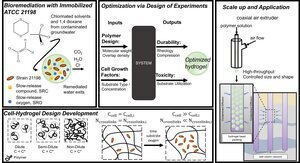
College of Engineering Unit:
We aim to develop and optimize manufacturing processes and mechanical properties of poly(vinyl)-alcohol (PVA)- Alginate (Alg) hydrogel beads with slow-release compounds (SRCs) for the immobilization of Rhodococcus rhodochrous ATCC 21198 for long term cometabolic bioremediation. To establish significant input parameters and ranges for optimization experiments, we have performed an array of studies on pre-gel polymer solutions and hydrogel beads. Rheology is carried out on different pre-gel polymer solutions to measure viscosity as a function of shear rate and applied to the extrusion process to ensure uniform size and spherical beads. A coaxial air flow bead generator system is adapted for high-throughput of beads with consistent size and shape. Beads are formed by dropping a pre-gel mixture of PVA, Alg, SRC and bacteria into a crosslinking solution of boric acid (BA) and calcium chloride (CaCl2) with a syringe pump. Cross-linking density is measured with compression and swelling ratio (SR) tests for PVA-Alg beads cross-linked at three concentrations of BA with a constant concentration of CaCl2. To maximize long-term durability of hydrogel beads, our objectives are to determine the maximum compressive modulus and minimum swelling ratio while maintaining a pH suitable for 21198. Unconfined compression tests are carried out on a rheometer and the linear region slope of the stress vs strain graph is taken to be Young’s Modulus, E. To determine the SR, beads are placed in a vacuum oven at 40C for 3 days to dry. Beads are rehydrated over time with the weight being noted. The SR is determined by dividing the rehydrated weight by the dehydrated weight and is directly proportional to the diffusion of solvent into cross-linked beads. Finally, we determine the critical overlap concentration of polymer coils, denoted C*, with rheological intrinsic viscosity measurements to find the entanglement density for PVA with four different molecular weight ranges based on the Mark-Houwink Sakurada equation. These data will provide input parameters and their appropriate ranges to further optimize our immobilization method via Design of Experiments.